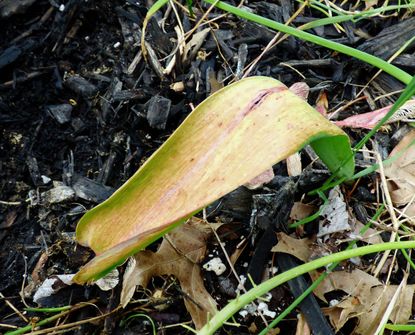Yellow Tulip Leaves: What To Do For Yellowing Leaves On Tulips


Don’t panic if you notice that your tulip leaves are going yellow. Yellowing leaves on tulips are a perfectly healthy part of the tulip’s natural lifecycle. Keep reading to learn more about yellowing leaves on tulips.
What Not to Do When Tulip Leaves are Yellow
So, your tulip leaves are turning yellow. If your tulip bulbs are healthy, the foliage will die down and turn yellow after blooming ends. This is 100 percent okay. The important thing, however, is that you must live with the yellow tulip leaves, even if you think they’re ugly. This is because the leaves absorb sunlight, which in turn provides energy to feed the bulbs throughout the winter. If you are impatient and remove the yellow tulip leaves, next year’s blooms will be less impressive, and every year you deprive the bulbs of sun, the blooms will become even smaller. You can safely remove the stems after the flower wilts but leave the foliage until they die down completely and come loose easily when you tug them. Similarly, don’t attempt to camouflage the foliage by bending, braiding, or gathering the leaves together with rubber bands because you will inhibit their ability to absorb sunlight. You can, however, plant some attractive perennials around the tulip bed to hide the leaves, but only if you promise not to overwater.
Tulip Leaves are Turning Yellow Early
If you notice your tulip leaves going yellow before the plants have even bloomed, it may be a sign that you are overwatering. Tulips perform best where winters are cold, and summers are relatively dry. Water tulip bulbs deeply after planting, then don’t water them again until you notice shoots popping up in spring. At that point, about an inch (2.5 cm.) of water per week in the absence of rainfall is enough. Similarly, your bulbs may be too wet if you planted them in poorly drained soil. Tulips require excellent drainage to avoid rot. Poor soil can be improved by adding generous amounts of compost or mulch. Frost can also cause blotchy, ragged leaves.
Gardening tips, videos, info and more delivered right to your inbox!
Sign up for the Gardening Know How newsletter today and receive a free download of our most popular eBook "How to Grow Delicious Tomatoes."

A Credentialed Garden Writer, Mary H. Dyer was with Gardening Know How in the very beginning, publishing articles as early as 2007.
-
 Urban Beekeeping Guide: Top Tips For Raising Bees In The City
Urban Beekeeping Guide: Top Tips For Raising Bees In The CityUrban beekeeping can be a rewarding and appreciated pastime, but first be sure it’s legal in your city and learn the ropes of beekeeping.
By Mary Ellen Ellis
-
 2024 Plant Of The Year: Why Experts Say Philodendron Is The “It” Plant Of The Year
2024 Plant Of The Year: Why Experts Say Philodendron Is The “It” Plant Of The YearWe aren’t surprised that philodendron was designated the plant of the year. Versatile, easy-care and lovely, it’s the houseplant of the year 2024!
By Bonnie L. Grant